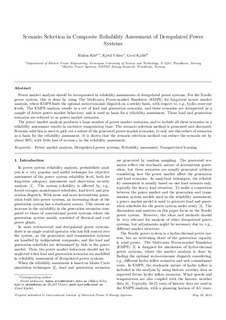| dc.contributor.author | Kile, Håkon | |
| dc.contributor.author | Uhlen, Kjetil | |
| dc.contributor.author | Kjølle, Gerd Hovin | |
| dc.date.accessioned | 2017-12-08T07:52:17Z | |
| dc.date.available | 2017-12-08T07:52:17Z | |
| dc.date.created | 2014-04-28T15:46:23Z | |
| dc.date.issued | 2014 | |
| dc.identifier.citation | International Journal of Electrical Power & Energy Systems. 2014, 63 (Dec), 124-131. | nb_NO |
| dc.identifier.issn | 0142-0615 | |
| dc.identifier.uri | http://hdl.handle.net/11250/2469620 | |
| dc.description.abstract | Power market analysis should be incorporated in reliability assessments of deregulated power systems. For the Nordic power system, this is done by using The Multi-area Power-market Simulator (EMPS) for long-term power market analysis, where EMPS finds the optimal socio-economic dispatch on a weekly basis, with respect to, e.g., hydro reservoir levels. The EMPS analysis results in a set of load and generation scenarios, and these scenarios are interpreted as a sample of future power market behaviour, and is used as basis for a reliability assessment. These load and generation scenarios are referred to as power market scenarios.
The power market analysis produces a large number of power market scenarios, and to include all these scenarios in a reliability assessment results in excessive computation time. The scenario selection method is presented and discussed. Scenario selection is used to pick out a subset of the generated power market scenarios, to only use this subset of scenarios as a basis for the reliability assessment. The paper provides some general guidelines for application of the scenario selection method. It is shown that the scenario selection method can reduce the scenario set by about 90%, with little loss of accuracy in the reliability assessment. | nb_NO |
| dc.language.iso | eng | nb_NO |
| dc.publisher | Elsevier | nb_NO |
| dc.rights | Attribution-NonCommercial-NoDerivatives 4.0 Internasjonal | * |
| dc.rights.uri | http://creativecommons.org/licenses/by-nc-nd/4.0/deed.no | * |
| dc.title | Scenario selection in composite reliability assessment of deregulated power systems | nb_NO |
| dc.type | Journal article | nb_NO |
| dc.type | Peer reviewed | nb_NO |
| dc.description.version | acceptedVersion | nb_NO |
| dc.source.pagenumber | 124-131 | nb_NO |
| dc.source.volume | 63 | nb_NO |
| dc.source.journal | International Journal of Electrical Power & Energy Systems | nb_NO |
| dc.source.issue | Dec | nb_NO |
| dc.identifier.doi | 10.1016/j.ijepes.2014.05.071 | |
| dc.identifier.cristin | 1130327 | |
| dc.relation.project | Norges forskningsråd: 199967 | nb_NO |
| dc.description.localcode | © 2014. This is the authors’ accepted and refereed manuscript to the article. This manuscript version is made available under the CC-BY-NC-ND 4.0 license http://creativecommons.org/licenses/by-nc-nd/4.0/ | nb_NO |
| cristin.unitcode | 194,63,20,0 | |
| cristin.unitname | Institutt for elkraftteknikk | |
| cristin.ispublished | true | |
| cristin.fulltext | postprint | |
| cristin.qualitycode | 1 | |

